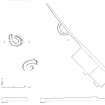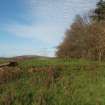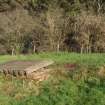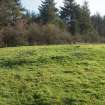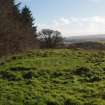Field Visit
Date 2 November 2018
Event ID 1048477
Category Recording
Type Field Visit
Permalink http://canmore.org.uk/event/1048477
Three small earthworks and the vestiges of one building are all that remain of a World War Two light anti-aircraft battery, which is visible on an RAF air photograph (106G/UK/1317/7054) flown on 27 March 1946 and also noted in a document held by the National Archives at Kew (WO 166 7369).
The three earthworks are situated in improved pasture on the S side of the summit of Barochan Hill. Two are roughly oval on plan and one at least must have protected the gun, while the other might possibly have protected the Predictor. The more northerly of this pair (NS 41293 69063) measures 7.7m from NW to SE by 6.3m transversely over grass-grown earthen banks up to 2m thick and 0.35m high. There is an entrance on the N. The more southerly (NS 41300 69052), situated 7m SE, measures 8m from ENE to WSW by 4.5m transversely over grass-grown banks 2.3m thick and 0.5m high. The entrance may have been on the SE. The third earthwork (NS 41315 69068) is situated immediately SW of the thorn hedge fringing the mixed plantation on the hill’s summit. It also appears to have been oval on plan, but only its SW half survives. This measures 6.5m from NW to SE by 4.5m transversely over grass-grown banks 2m thick and 0.25m high. The building (NS 41327 69050) is situated about 10m SE of this poorly preserved earthwork and 2m SW of the thorn hedge. It is rectangular on plan, measuring 19m from NE to SW by 6m transversely and is divided into two equal compartments. The NW compartment is defined by brick walls 0.3m thick and 0.15m high, with a threshold at its S corner marking the position of an entrance. The SE compartment is distinguished by a concrete platform supported on a brick plinth up to 0.45m high. There is a threshold at its S corner, but this is now partly overlain by a large rectangular fragment of concrete.
The earthworks are a rare survival and the battery was one of at least twelve constructed to protect the Bishopton Royal Ordnance Factory (NS47SW 149). Similar arrangements of light anti-aircraft batteries were established around a number of vulnerable points, either military or industrial, along the banks of the Clyde.
Visited by HES, Survey and Recording (ATW, AMcC), 2 November 2018.












